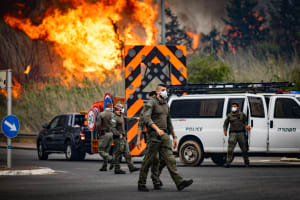True peace or short-term truce? The Islamic meaning of ‘hudna’ and its impact on Israeli-Palestinian negotiations
The Arabic word for 'ceasefire' carries different connotations

In discussions about ceasefire proposals between Israel and Hamas – both in the current Gaza War that began on Oct. 7, 2023, and in past conflicts – one often overlooked issue in the West is the differing interpretations of the term "ceasefire" used in negotiations.
In Western thought, a ceasefire is often viewed as a step towards a peace agreement. While it can refer to merely a cessation of violence, in most Western-style negotiations, the cessation of hostilities is viewed as a precursor to an agreement that could lead to peace.
However, the Arabic word often used for ceasefire in the negotiations between Israel and Hamas does not carry those connotations in Islamic thought.
The Arabic word hudna (هدنة) can translate to "truce" or “ceasefire," but it carries significant weight in Islamic jurisprudence and historical usage.
Definition and Etymology
The Arabic word hudna derives from the Arabic root h-d-n (ه-د-ن), which means "to be calm," "to become quiet." In classical Arabic, it can refer to a temporary agreement to cease fighting. In Modern Standard Arabic (MSA), hudna refers to a temporary truce or ceasefire between warring parties, typically with a defined duration. It does not refer to a permanent peace or reconciliation (sulh in Arabic), rather, it means a pause in fighting that allows for negotiation, rearming, or other strategic regrouping.
Usage in Islamic Jurisprudence
The word hudna also has a well-established meaning and usage in Islamic jurisprudence, based on passages from the Hadith (the collected sayings of the Prophet Muhammad). It is often used in the context of jihad (struggle or warfare). The word hudna, though, does not appear in the Quran itself.
Perhaps the most significant use of the word hudna in Islamic tradition and interpretation is the Treaty of Hudaybiyyah in AD 628, which was a 10-year truce between Muhammad and the Quraysh tribe of Mecca.
The agreement allowed Muhammad’s followers to perform the pilgrimage to Mecca and forbade hostilities between the two groups.
The ceasefire agreement did not last long, with Muhammad claiming violations of the agreement about two years later, which led him to break the hudna and attack Mecca, capturing the city. However, the Treaty of Hudaybiyyah established that a hudna is permissible even if it appears to disadvantage Muslims temporarily, as long as it serves a greater strategic or communal interest for the Muslims. For some Islamic jurists, it also set a precedent for a time limit for such a truce, typically not exceeding 10 years.
While there are different opinions in the major schools of Sunni and Shia Islam about a hudna, they tend to agree on several points:
A hudna is allowed when it benefits the Muslim community, by preserving lives, reorganizing/rebuilding forces, or creating opportunities for the spreading of Islam;
It must have a time limit, although it can be renewed for the benefit of the community;
Only the leader of a Muslim community can authorize one on behalf of his community. The hudna cannot involve the violation of Islamic principles, such as permanently surrounding Muslim territory, compromising the five pillars of Islam, or giving up Muslim rights;
The hudna cannot be violated unless there is a betrayal by the other side.
A hudna differs from peace (sulh) in that the latter can only be offered to another Muslim state or group, while a hudna can be offered to non-Muslims.
When a hudna is negotiated with non-Muslims, even the slightest infractions can be deemed a violation of the terms, especially if the hudna has allowed the Muslim fighters to rearm, regroup, or gain some other strategic advantage.
Hudna in Modern History
The term hudna has been used by the Palestinian groups to describe all of their ceasefire agreements with Israel during the Israeli-Palestinian conflict.
Recent examples include the declaration of a hudna in 2003, during the Second Intifada, which allowed for negotiations between Israel and the Palestinian terror groups, while also allowing the Palestinian groups to hold discussions on coordination between each other.
The end of Operation Guardian of the Walls in 2021 came with the agreement for a hudna.
While Israeli leaders and negotiators are aware of the term’s meaning and usage, Western negotiators are often unaware. Thus, when Western leaders import Western values and ideas into the term ceasefire, they misunderstand the basic starting point and goal for groups like Hamas in conducting such negotiations.
Dr. Mordechai Kedar, an Israeli scholar of the Middle East at Bar-Ilan University, has often warned about misunderstanding the term and its impact on the Israeli-Palestinian conflict.
"If you, the Muslim, are weak and the infidel is too strong, you can give him a temporary peace," Kedar explains. "The second thing is, if the infidel falls asleep on guard, you can do whatever you like to him, even within the time of the temporary peace, because this is what Muhammad did.”
An Islamic Jihadist group like Hamas could never agree to peace (sulh) with Israel, as such an agreement would violate the Islamic principle that land conquered by Muslims can never be voluntarily surrendered. Since a peace agreement with Israel would entail such a surrender of formerly Islamic land, Hamas will never agree to such terms.
The group’s refusal to disarm, as seen in the current round of negotiations is another example of this. Hamas is not seeking a permanent peace with Israel, it seeks to regroup and develop a new strategy. That explains also why the group is willing to hand over control of the Gaza Strip to another Arab (Muslim) group, including its political enemy, the Palestinian Authority, but unwilling to accept Israeli or Western control of the enclave.
In the conclusion of his 2008 article “Tactical Hudna and Islamist Intolerance”, Dr. Denis MacEoin asked the question, “Can Western governments do anything to prevent a new hudna running its usual course?”
“Diplomats may propose carrot and stick strategies, offering financial and political incentives to dismantle the culture of violence with disincentives for any return to killing. In the end, though, the onus is on the Palestinians and their allies,” Dr. MacEoin argued.
“If they could impose a hudna on their own side and not fire Qassam and Grad rockets, smuggle weapons, or infiltrate suicide bombers into Israel, there could be a chance for Gaza to develop. But such a scenario is a pipe dream so long as Hamas remains a viable entity.”
With Egypt and Qatar taking a greater role in the current negotiations, perhaps the question should be asked - are those two nations negotiating for a hudna or for sulh?
If Western nations desire a lasting peace, working with partners who are only seeking a temporary ceasefire, which would allow Hamas to rearm, re-establish, and regroup, is not a workable strategy.

J. Micah Hancock is a current Master’s student at the Hebrew University, pursuing a degree in Jewish History. Previously, he studied Biblical studies and journalism in his B.A. in the United States. He joined All Israel News as a reporter in 2022, and currently lives near Jerusalem with his wife and children.
You might also like to read this:

















